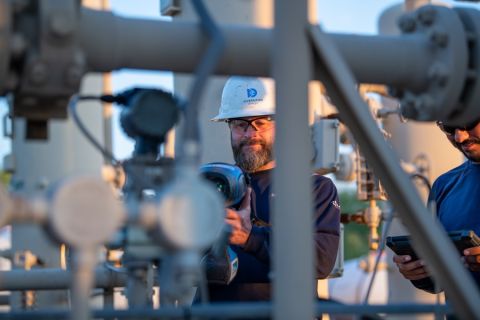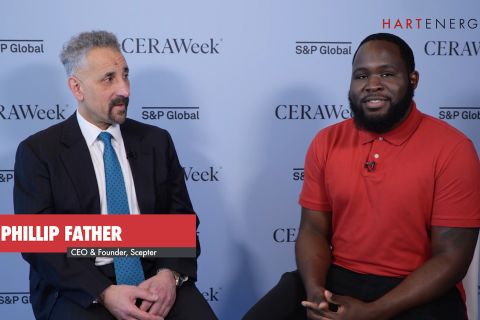
Lara Jones, CEO of Be A Legend and G.R.I.T. Global, author of “Hunt or be Hunted” and inspiration to thousands every year, started off in the U.S. with nothing more than a laptop and her brain.
“There was a time when I couldn’t even eat for three days because it was a choice between rent and food,” she said.
But the Influential Women in Energy keynote speaker made a choice: She was going to make an impact on the world, tell her story and guide others using the tools that had helped her in her time of need.
Jones developed a system called G.R.I.T., a tailored framework to transform fears into action with meaningful impact and the ability to grow.
She left a successful career in the U.K. to come to the U.S. and begin working on her dream. It was frightening, but Jones, who likens herself to a lion, did not let fear define her.
“Be afraid, but do it anyways,” she said. “The worst that happens is a setback, and every setback is just a setup for a comeback.”
Now, Jones travels all over the world, a far cry from her humble beginnings. She teaches her system at Fortune 500 companies, to the U.S. military, celebrities, executives and anyone who makes the mistake of letting her have a white board.
“Every time I speak, it’s related to the audience,” she said. “When you come and speak at an event, it’s not about you, it’s about others. The stage is a platform for you to impact so many people and for them to walk away feeling not just inspired or motivated, but they’ve got to feel equipped with the tools necessary to go out and do what they need to do.”
The four pillars
G: Get it done
“You have to start with ‘G,’” Jones said. “You adopt the process, you adopt the Global G.R.I.T. system or you can adopt whatever other teachings or start all over again with a new challenge…”
The other aspects of the program—the “R,” “I” and “T”— don’t come into play until the ‘G’ is mastered.
“I’m naturally a go-getter,” Jones said. “I’m a ‘get it done’ girl. I take action. I don’t hesitate.”
But sometimes the “Get it done” aspect of G.R.I.T. isn’t the best choice.
In 2022, Jones tragically lost her youngest son and almost died the same night.
“I came home from the hospital with my son’s ashes instead of him alive,” she said. “How do you get through such a devastating time and tragedy in your life?”
It took four months for the naturally outgoing and energetic entrepreneur to get herself moving again.
“I started to reverse engineer how I got through many, what I call, ‘gritty’ situations in the past and I knew I’d have to amplify that times 1,000, if not more, to get through this.”
But Jones knew, even then, that her typical coping tools wouldn’t work this time.
“I realized that if I had utilized the ‘Get it done’ approach, I would not be sitting here speaking today,” she said. “I would not be up on stages impacting millions of people across the world. It just wouldn’t have happened. It would have put me either into an early grave or I would be a shadow of who I really was because I wouldn’t be able to cope with all the stresses and the anxiety and the PTSD that I was diagnosed with.”
G.R.I.T. isn’t always straightforward, she explained.
“Sometimes you have to adopt the ‘R’ before you can start the ‘G,’” she said.
R: Reframe your thinking
Most people, when faced with a new situation, a new life or professional challenge, start in a “comfort zone.” Not necessarily a place of physical, mental or emotional comfort, Jones explained, but one of static beliefs that are “easy” to stay in and can hold them back.
The trick is to decide to challenge that belief, change the perspective and move on from there.
“I wouldn’t have been able to cope with losing my son,” Jones said. “I would’ve tried to bury it and, at some point, it would’ve come back to bite me. I realized I had to reframe everything that had happened to me.”
Four months after her son died, Jones had made her decision.
“I woke up and I looked at myself in the mirror and I said, ‘You got to wake up today; your son did not. You got to feel the sun on your skin today; your son did not. Stop making this about you. It’s not about you anymore; it’s about others.’”
Jones decided that her new goal was to use her trauma, grief and adversity as fuel to enable her to impact others, rather than let it continue to consume her.
“I realized that was the ‘R’ in my G.R.I.T., ‘Reframe thinking,’” she said. “I started thinking about things differently. Instead of thinking, ‘Look what’s been taken away from me,’ I started thinking, ‘Look what was given to me.’”
I: Impact others
When Jones did look at what she was given, and what she already had, she realized that she could make a difference every day.
“From that moment, I just said, ‘My main mission in life is to impact at least one person for every day I am breathing,’” Jones said. “And I’ve never looked back.”
The ‘I’ in G.R.I.T is especially important for those in leadership positions, Jones said.
“Remember that it’s not about you,” she said. “No matter whether you’re speaking on a stage, no matter whether you are working on a team, whether you’re at home with your family … It’s not about you, it’s about others, because people won’t remember exactly what you said, but they’ll remember how you made them feel.”
When a leader makes a positive impact on members of her team, it empowers and motivates them to change their beliefs and open themselves up to a growth mindset.
T: Take responsibility
“It’s at this point that you have to take ownership of not just your actions but your inactions,” Jones said.
A possibly counterintuitive way to do so, she said, is by embracing vulnerability.
For many women in male-dominated industries, one of the biggest “comfort zone” belief is that they are not allowed to express vulnerability lest they be seen as weak and unfit.
“After my son passed away, I was very quiet for four months,” Jones said. “All the businesses I served with, my other company, all of them, every single one of them were male leaders. All the C-suite were male. And I had this fear of, ‘Wait a minute, if I tell them that I just lost my son and nearly my life and show vulnerability, are they going to see me as weak because I’m female, too? Are they going to see me as someone that’s too vulnerable to be in this position to be able to help their organizations?’ Oh, I had that fear.”
She decided to reframe that belief.
“I turned around and said, ‘You know what? If I come out with this and I show my vulnerability and it’s accepted, think what that could do to change industries.’”
She took the risk, taking full responsibility and ownership over her decision to share her grief publicly, despite her fears. Rather than call her weak, many of the people she was worried about told her how they admired her strength.
Sometimes learning to believe in yourself needs practice and a little bit of courage.
“I would question or challenge if someone came to me and said, ‘I have this fear and I don’t want to be seen as vulnerable, I don’t want to be seen as weak,’” Jones said. “I’m going to question that and say, ‘Why do you think you’re going to be seen as weak?’ I was not seen as weak. I was seen as a very powerful woman because I came out with my story and I’ve continued to make myself vulnerable.”
To see the full list of Hart Energy's 2024 Influential Women in Energy, click here.
Recommended Reading
Keeping it Tight: Diversified Energy Clamps Down on Methane Emissions
2024-04-24 - Diversified Energy wants to educate on emission reduction successes while debunking junk science.
Darbonne: The ESG Sword: BlackRock's Life, Death by ESG
2024-04-17 - BlackRock, the $10 trillion investment manager, is getting heat for too much ESG investing, while shareholders are complaining it’s doing too little.
Fire Closes Atlas Energy’s Kermit, Texas Mining Facility
2024-04-15 - Atlas Energy Solutions said no injuries were reported and the closing of the mine would not affect services to the company’s Permian Basin customers.
Coalition Launches Decarbonization Program in Major US Cities, Counties
2024-04-11 - A national coalition will start decarbonization efforts in nine U.S. cities and counties following a federal award of $20 billion “green bank” grants.
Exclusive: Scepter CEO: Methane Emissions Detection Saves on Cost
2024-04-08 - Methane emissions detection saves on cost and "can pay for itself," Scepter CEO Phillip Father says in this Hart Energy exclusive interview.





